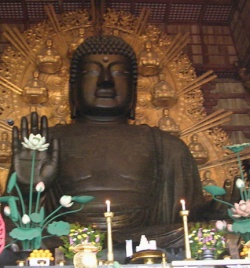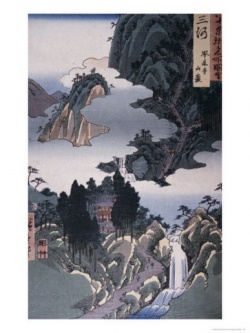Second Turning of Dharma Wheel
During his Second Turning of Dharma Wheel in Rajagriha at Vulture Peak Mountain, Buddha represented his teaching with wisdom sutras, a collection of sutras known as Prajnaparamita (Ultimate Wisdom). These sutras were mostly explaining the notion of Emptiness and transcendental states of consciousness associated with realization of emptiness. The second turning of Dharma wheel is usually seen as revealing deeper meaning of the notions which Buddha had started to explain during the first turning of wheel.
Buddha was telling how important it is to realize the fundamentally unsatisfactory nature of our ordinary life, sufferings and sorrows characteristic to existence. However, during his second turning of Dharma wheel, the focus was considerably shifted. Here Buddha recommended to practitioners to expand borders of their conceptions about the nature of sufferings, including there also all other beings. Thus, the second turn of wheel exceeded the first one by width and depth of its insight.
From the viewpoint of examination of causes of suffering, the second turning was also more complete. Except of confusion and attachment, Wisdom Sutras clearly and precisely point to several other types of subtle obscurations, which don’t allow perceiving reality without our usual clinging to the independent existence of all phenomena. Thus, from this point of view, the cause of sufferings is seen not only as obvious factors of deliberate ignorance and attachment, but also as subtle imprints in consciousness and manifestations of these defilements.
In a similar way, the examination of the Third Noble Truth during second turning of Dharma wheel, the true cessation of suffering, acquires greater depth and complexity. Contrary to the teachings in sutras of the first turn of Dharma wheel, here Buddha examines the nature of cessation of sufferings in general, its particular characteristics and so on.
Also the Fourth Noble Truth about the right path was explained more profoundly. Regarding the path to awakening itself, in wisdom sutras Buddha shows a unique path, based on deep realization of emptiness – non I, the way all things really are. This understanding is developed on the basis of universal compassion and bodhichitta (genuine altruistic aspiration to achieve full awakening for the benefit of all sentient beings), which is the attitude characteristic to the practitioner of Mahayana.
Combination of realization of emptiness and bodhichitta gives a complete unity of wisdom and compassion. The factor of wisdom in this context applies first of all to practice of emptiness, while altruistic motivation, which moves this wisdom to realization of ideals of compassion, is a method and path to reach the goal. Teaching about unity of wisdom and compassion were explained during the second turning of Dharma wheel.
The explanation of Four Noble Truths during the second turning of Dharma wheel in Rajagriha was deeper than during the first not just because of few more details mentioned in wisdom sutras, which didn’t find a place during the first turning. Wisdom sutras explain not only various aspects of Four Noble Truths, not expounded during the first one, but because more deeply and in detail do conclusions out of principle of causality, which lies in foundations of Four Noble Truths. Moreover, this development of the teaching about Four Noble Truths, have its place in the basic structure of teaching about the path, which was explained during the first turning of wheel.Due to more profound elaboration of the notion of emptiness (lack of a genuine reality or true nature of all phenomena), the second turning of the Dharma wheel is called the "wheel of Dharma, which refers to the absence of innate characteristics."
Additionally, in the scriptures from the second turning of Dharma wheel we can find several spots, which might seem contradictory to the general structure of the teaching, which was formulated during the first turning of Dharma wheel. For this reason Mahayana Buddhism differentiates two categories of texts:
1. Texts, which require interpretation – those texts where meaning should be considered as an intermediate, and which, therefore, require further interpretation beyond their literal meaning, and
2. “Finalized” texts – the meaning of which can be understood directly and literary.
With such a hermeneutical approach, a crucial role here plays the well-known Mahayana principle of “four pillars”:
1. Rely on teaching, not the teacher
2. Rely on meaning, not the words, which express it
3. Rely on final meaning, not the intermediate one;
4. Rely on ultimate wisdom of inner experience, not just a knowledge
According to the first of “four pillars”, when we listen to teacher or read a text, we should judge if it is true, what is said, not according to reputation, wealth, position or power of the author, but according to merits of teaching itself. The second pillar states, that we should judge about text not by virtue of its literary merits, but how much sense it brings regarding its subject. The third pillar prescribes to judge about a proposition not by its intermediate, temporary meaning, but from the perspective of its final conclusions.
And, finally, according to the fourth pillar, even if we rely on the meaning of final conclusions, we should judge about it from the viewpoint of inner experience of wisdom and understanding, not mere intellectual knowledge on subject. Actually, we can find endorsement of Buddha himself to this approach:
O Bhikkhus and sages! Just as a goldsmith tests his gold, burning, cutting and rubbing it – likewise, you should accept my words only after a thorough examination, not because of respect to me.
Summarizing it, we can say that during the second turning of Dharma wheel, the way it is given in sutras on ultimate wisdom, Buddha is extensively elaborating the topic of cessation of sufferings, expounding profound teachings on emptiness.
Hermeneutical approach also helps us to find the hidden meaning of different sutras. For example we can discover that, while superficially the subject of wisdom sutras is the topic about emptiness, we can find also the hidden meaning of these texts. Here the subject of these sutras appears to be the transcendental experience of different stages, which is related to realization of emptiness and what are consecutive steps of development on the way to awakening. This level of meaning in wisdom sutras is called hidden, secret or implied meaning.


